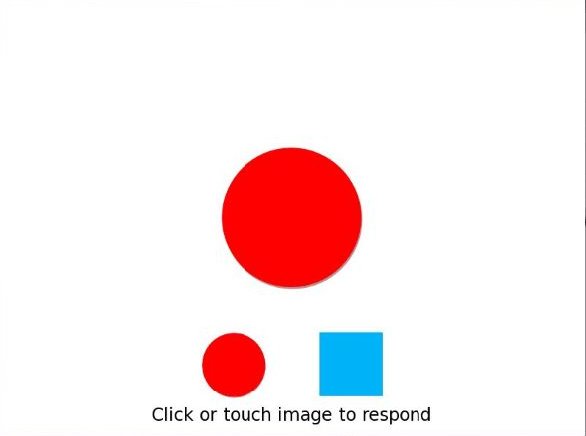Bivalent Shape Task

System Requirements
Minimum: 1024×768
Recommended: 1280×800
May be challenging for colorblind participants
Description
The Bivalent Shape Task Version 1.0 (Esposito et al., 2014). A simple nonverbal dimensional filtering task akin to the stroop task.
About This Test
A dimensional filtering task designed for children and adults that assesses interference suppression. Participants respond to colored shapes (blue circles, yellow circles, blue squares, yellow squares) that appear on screen, responding by clicking or pressing keys corresponding to response options shown at the bottom. The task includes practice, neutral (shapes without color variation), congruent (shape and color map to same response), incongruent (shape and color map to different responses), and mixed blocks. Participants must attend to the target dimension while ignoring the irrelevant dimension. Supports both mouse/touch and keyboard input modes.
Test Details
BSTBST.pbl🚀 Try Without Registration
Run this test immediately without creating an account. Data stays in your browser.
Researcher Access Benefits
To save configurations, upload data, use translations, track completion, and manage studies, please log in or register for an account.
Scientific Background
PEBL-Specific References:
These studies used the PEBL version of this task.
- Esposito, A. G., Baker-Ward, L., & Mueller, S. T. (2013). Interference suppression vs. response inhibition: An explanation for the absence of a bilingual advantage in preschoolers' Stroop task performance. Cognitive Development. http://www.sciencedirect.com/science/article/pii/S0885201413000518
- Mueller, S. T., & Esposito, A. G. (2014). Computerized testing software for assessing interference suppression in children and adults: the bivalent shape task (BST). Journal of open research software, 2(1), e3.
Data Output
Creates multiple data files: (1) BST-<subnum>.csv with trial-by-trial data containing columns: subnum (participant code), type (block type: 'practice', 'neutral', 'congruent', 'incongruent', or 'mixed'), block (block number), congruency (trial congruency: 1=congruent, -1=incongruent, 0=neutral/not applicable), trial (trial number), stim (stimulus ID: 1-4 representing different shape-color combinations), resp (participant response: -1=timeout, or response identifier), corr (trial accuracy: 1=correct, 0=incorrect), rt (response time in ms), tooslow (whether timeout occurred: 1=timeout, 0=responded); (2) report-<subnum>.txt containing text summary with accuracy and RT statistics by block type; (3) BST-all.csv containing summary statistics with columns for participant code, timestamp, and accuracy/RT measures for each condition (ACC_PI=Practice Incongruent accuracy, ACC_PN=Practice Neutral accuracy, ACC_PC=Practice Congruent accuracy, ACC_MI=Mixed Incongruent accuracy, ACC_MN=Mixed Neutral accuracy, ACC_MC=Mixed Congruent accuracy, RT_PI through RT_MC for corresponding RTs).
Example Data
| subnum | test | type | block | congruency | trial | stim | resp | corr | rt | tooslow |
|---|---|---|---|---|---|---|---|---|---|---|
| 1 | BST | practice | 0 | 0 | 1 | 6 | <rshift> | 1 | 1276 | 0 |
| 1 | BST | practice | 0 | -1 | 2 | 4 | <lshift> | 1 | 1182 | 0 |
| 1 | BST | practice | 0 | -1 | 3 | 2 | <rshift> | 1 | 941 | 0 |
| 1 | BST | practice | 0 | 1 | 4 | 3 | <rshift> | 1 | 730 | 0 |
| 1 | BST | practice | 0 | 0 | 5 | 5 | <lshift> | 1 | 1331 | 0 |
| 1 | BST | practice | 0 | 1 | 6 | 1 | <lshift> | 1 | 770 | 0 |
| 1 | BST | neutral | 1 | 0 | 1 | 5 | <lshift> | 1 | 1474 | 0 |
| 1 | BST | neutral | 1 | 0 | 2 | 6 | <rshift> | 1 | 652 | 0 |
| 1 | BST | neutral | 1 | 0 | 3 | 5 | <lshift> | 1 | 1024 | 0 |
Sample data showing typical output format. Actual values will vary by participant.
About This Test
The Bivalent Shape Task Version 1.0 (Esposito et al., 2014). A simple nonverbal dimensional filtering task akin to the stroop task.
Category: Executive Function
Estimated Duration: 10 minutes
Available Translations: 8 languages
Documentation Sources:
Test description file, Test implementation, PEBL wiki archive, Parameter schema
Documentation Status: Complete